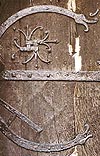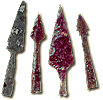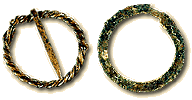![]() Metalwork
Metalwork


 Iron
and all the non-ferrous metals were worked with a high degree of skill in
the 11th - 12th centuries.As far as iron is concerned, however, it was not
possible, as it is today, to heat a furnace to a sufficiently high temperature
either to smelt it from its ore or to cast it into objects by making it molten.
Each iron object had therefore to be forged individually by a blacksmith.
One of the smith's greatest skills was the ability to introduce small amounts
of carbon into iron to make steel which was used in the production of tools
and weapons. Iron was also used to make the body armour and horse equipment
which were becoming increasingly sophisticated in this period. Another of
the blacksmith's specialities was locks and keys and on occasion his artistic
ability was allowed full expression in the decorative straps and hinges on
church doors and chests.
Iron
and all the non-ferrous metals were worked with a high degree of skill in
the 11th - 12th centuries.As far as iron is concerned, however, it was not
possible, as it is today, to heat a furnace to a sufficiently high temperature
either to smelt it from its ore or to cast it into objects by making it molten.
Each iron object had therefore to be forged individually by a blacksmith.
One of the smith's greatest skills was the ability to introduce small amounts
of carbon into iron to make steel which was used in the production of tools
and weapons. Iron was also used to make the body armour and horse equipment
which were becoming increasingly sophisticated in this period. Another of
the blacksmith's specialities was locks and keys and on occasion his artistic
ability was allowed full expression in the decorative straps and hinges on
church doors and chests.
 The
non-ferrous metals, including silver, copper and lead, could be heated to
melting point and were therefore extracted from their ores in a fairly pure
form. They could also be cast in moulds allowing the replication of objects
on a large scale. Such objects included small day-to-day items like buckles
and rings, but it was also possible to achieve elaborate three dimensional
effects and some of the bronzes of the period, such as the Gloucester candlestick,
are artistic achievements of the highest order.Casting employed the lost wax
method in which a wax model of the intended product was covered by clay to
form a mould which was then heated to melt the wax. After the wax had been
poured away, the metal replaced it in the mould and took on the form of the
model.
The
non-ferrous metals, including silver, copper and lead, could be heated to
melting point and were therefore extracted from their ores in a fairly pure
form. They could also be cast in moulds allowing the replication of objects
on a large scale. Such objects included small day-to-day items like buckles
and rings, but it was also possible to achieve elaborate three dimensional
effects and some of the bronzes of the period, such as the Gloucester candlestick,
are artistic achievements of the highest order.Casting employed the lost wax
method in which a wax model of the intended product was covered by clay to
form a mould which was then heated to melt the wax. After the wax had been
poured away, the metal replaced it in the mould and took on the form of the
model.
Decorative treatment of metalwork included gilding and the use of niello, a black compound made of silver and lead or copper. Champlevé, involving heating powdered glass to fill panels on the surface of an object is also known.